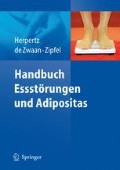Auszug
Die Energieaufnahme ist komplex geregelt. Dies ist in Anbetracht der Tatsache, dass eine erhebliche Fehlregulation — insbesondere zum Untergewicht — für den Körper vital bedrohlich ist, verständlich und notwendig. Die Schaltstellen der Energieaufnahme sind daher, wie weiter unten gezeigt wird, durch viele parallele Strukturen auf verschiedenen Ebenen und in vielen Organen vernetzt.
Access this chapter
Tax calculation will be finalised at checkout
Purchases are for personal use only
Preview
Unable to display preview. Download preview PDF.
Literatur
Arch JRS (2002) Lessons in obesity from transgenic animals. J Endocrinol Invest 25:867–875
Bogardus C, St Lillioja E, Ravussin W et al (1986) Familial dependence of the resting metabolic rate. N Engl J Med 315:96–100
Lichtman SW, Pisarska K, Berman ER et al (1992) Discrepancy between self-reported and actual caloric intake and exercise in obese subjects. N Engl J Med 327:1893–1898
Martinez-González MA, Martinez JA, Hu FB, Gibney MJ, Kearney J (1999) Physical inactivity, sedentary lifestyle and obesity in the European Union. Int J Obes 23:1192–1201
Oldrige N, Perkins A, Marchionni N, Fumagalli S, Fattirolli F, Guyatt G (2002) Number needed to treat in cardiac rehabilitation. J Cardiopulm Rehab 22:22–30
Prentice AM, Black AE, Coward WA et al (1986) High levels of energy expenditure in obese women. Br Med J 292:983–987
Ravussin E, Swinburn BA (1993) Energy metabolism. In: Stunkard AJ, Wadden TA (eds) Obesity: theory and therapy. Raven, New York, pp 97–123
Ravussin E, Lillioya S, Knowler WC et al (1988) Reduced rate of energy expenditure as a risk factor for body-weight gain. N Engl J Med 318:467–472
Rolls JR, Roe LS, Beach AM, Kris-Etherton PM (2005) Provision of foods differing in energy density affects long-term weight loss. Obes Res 13:1052–1060
Wirth A, Engeli S, Hinney A, Reinehr T (2007) Adipositas: Epidemiologie, Ätiologie, Folgekrankheiten und Therapie, 3. Aufl. Springer, Berlin Heidelberg New York
Author information
Authors and Affiliations
Editor information
Editors and Affiliations
Rights and permissions
Copyright information
© 2008 Springer Medizin Verlag Heidelberg
About this chapter
Cite this chapter
Wirth, A. (2008). Ätiologie und Diagnostik der Adipositas. In: Herpertz, S., de Zwaan, M., Zipfel, S. (eds) Handbuch Essstörungen und Adipositas. Springer, Berlin, Heidelberg. https://doi.org/10.1007/978-3-540-76882-1_40
Download citation
DOI: https://doi.org/10.1007/978-3-540-76882-1_40
Publisher Name: Springer, Berlin, Heidelberg
Print ISBN: 978-3-540-76881-4
Online ISBN: 978-3-540-76882-1
eBook Packages: Medicine (German Language)

